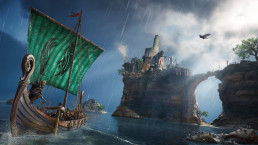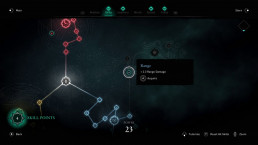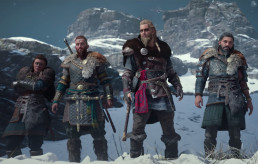Can a game be too big? Ask anyone who played Assassin's Creed Odyssey and the answer is probably yes. Not only the game world was immense, the game itself was bursting at the seams with the amount of weapons, gear, skills, upgrades for your boat, mercenaries and cultists. Fortunately, Ubisoft has pulled out the trimmer for Assassin's Creed Valhalla, in a good way.
In Assassin’s Creed Valhalla you take on the role of Eivor and choose whether you play as a male, female or let the Animus decide for you. A completely cosmetic choice that does not change the course of the game. But because I played as a male Eivor, I refer to “him” in this review. Eivor is one of the many Vikings who left Scandinavia at the end of the ninth century and tries to settle in England.
Medieval England relied more on its natural beauty than its prominent landmarks, for even London at the time was little more than a peasant settlement built on Roman ruins. Despite its primitiveness, England at that time was a powder keg that was about to explode. The country is divided into four different kingdoms. Foreign invaders, such as Eivor, are increasing tensions. Of course The Order of the Ancients appears to be pulling all kinds of strings in the background. Before Eivor knows it, he is involved in a plot that is much bigger than his own ambition to build a settlement.
That sounds like run-of-the-mill Assassin’s Creed material, but Valhalla does a number of things significantly differently from its predecessors. Take, for example, the way the story is divided. Valhalla consists of clear Arcs, which are also presented as such. Each story arc has a clear beginning and end and always focuses on a specific area. In one story arc you have to help a local king stay in power and you fight in great battles in which you storm a castle in stages. Another storyline takes more inspiration from the classic Assassin’s Creed and relies on detective work and assassinations with the Hidden Blade.
Story missions follow each other relatively quickly within such a story arc, without the player being distracted all the time. Side missions and activities are still plentiful and you are free to undertake them whenever you feel like it, but it feels more natural to explore the land in between those story arcs. In addition, side missions no longer “pollute” your quest list: they are really meant to be done immediately and quickly in between. This creates a nice balance of playing missions, exploring the landscape and undertaking side activities.


Even during missions, Assassin’s Creed Valhalla is more reserved with its icons and clues. An example, at one point I run into two Normans who want to plunder a house. However, they do not have a torch and therefore cannot set anything on fire. And what’s looting without a bright bonfire? Instead of immediately showing what you need to do, the game leaves it to your own imagination that you can light the thatched roof with a torch.
In another mission, I must uncover a traitor. It is possible to immediately point out a culprit, but you can also interrogate people in the village or follow a whole trail into the swamp. Instead of knowing exactly how many hints you still have to collect, you now have to rely more on your own instinct.
Having to think for yourself is often a lot more fun than just running to the next arrow on the map, but unfortunately Assassin’s Creed is not always suitable for this. “Traditionally” it sometimes happens that you suddenly cannot address a character or that a required object does not want to load. Previously you had realized that it was better to reload a checkpoint, but now you regularly remain in the dark, am I doing something wrong, or is the game broken?
The slight suspicion that something is technically not going quite right is certainly not unfounded. Valhalla has the necessary rough edges. Think of hard transitions between videos and gameplay, missing sound effects or spontaneous, spastic animations. But also at gates and doors that remain closed after respawning, so that part of the men remains behind during a castle storm.
The animations during fighting don’t always look smooth either. There is a strange contrast between how flashy fast Eivor can evade and how slow he throws a flail around. With special attacks, the animations often do not quite match each other, causing Eivor to either fall into the air, or make a very strange jump.


That said, fighting in Valhalla feels very satisfying once you get the hang of the combat system. It is no longer necessary to equip Eivor with new weapons on the assembly line and therefore does not always have to get used to other properties. You will find new weapons with different characteristics, but they are not necessarily better or worse than the one you already have. If you want, you can finish the entire game with the same axe.
The axe, the hammer, The Flail. Each weapon feels different, but each one gives you a sense of unadulterated brutality befitting the Vikings. Flying limbs and decapitations are therefore the order of the day. Valhalla takes some getting used to after the fairly light-hearted Odyssey, but fortunately there was also room for a humorous note in the Middle Ages.
Especially “Flyting” regularly causes a big grin on the face. In these Viking “Rap” Battles you always have to choose a phrase that not only rhymes with what your opponent just said, but also something that fits in rhythm. Eivor does not hesitate to talk about someone’s physical characteristics or mother, but finding the right diss is easier said than done. Perhaps the best side activity is the tactical dice game Orlog. The rules of the game are simple enough that you get it after one time, but complicated enough to keep you fascinated again and again.
That is actually the common thread of all of Assassin’s Creed Valhalla. Compared to its predecessor, Valhalla is a lot easier to understand, with fewer game mechanics, stats and distractions. At the same time, the content that remains is structured in such a way that you as a player are drawn even more into the game world.
Score:
8,5
+ Suitable and cool Viking weapons
+ Pleasant balance between main and side missions
+ Original and fun activities such as flyting and Orlog
+ Missions are less layed out before you
– Several bugs and technical flaws at launch
– Missions sometimes unclear